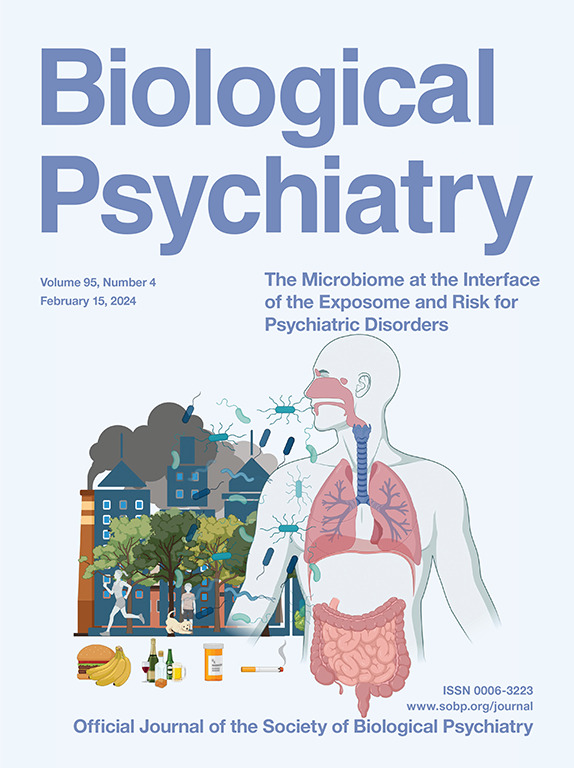Polyconnectomic Scoring of Functional Connectivity Patterns Across Eight Neuropsychiatric and Three Neurodegenerative Disorders
IF 9
1区 医学
Q1 NEUROSCIENCES
引用次数: 0
Abstract
Background
Neuropsychiatric and neurodegenerative disorders involve diverse changes in brain functional connectivity. As an alternative to approaches that search for specific mosaic patterns of affected connections and networks, we used polyconnectomic scoring to quantify disorder-related whole-brain connectivity signatures into interpretable, personalized scores.
Methods
The polyconnectomic score (PCS) measures the extent to which an individual’s functional connectivity mirrors the whole-brain circuitry characteristics of a trait. We computed PCSs for 8 neuropsychiatric conditions (attention-deficit/hyperactivity disorder, anxiety-related disorders, autism spectrum disorder, obsessive-compulsive disorder, bipolar disorder, major depressive disorder, schizoaffective disorder, and schizophrenia) and 3 neurodegenerative conditions (Alzheimer’s disease, frontotemporal dementia, and Parkinson’s disease) across 22 datasets with resting-state functional magnetic resonance imaging data from 10,667 individuals (5325 patients, 5342 control participants). We also examined PCSs in 26,673 individuals from the population-based UK Biobank cohort.
Results
PCSs were consistently higher in out-of-sample patients across 6 of the 8 neuropsychiatric and across all 3 investigated neurodegenerative disorders ([minimum, maximum]: area under the receiver operating characteristic curve = [0.55, 0.73], false discovery rate–corrected p [pFDR] = [1.8 × 10−16, 4.5 × 10−2]). Individuals with elevated PCS levels for neuropsychiatric conditions exhibited higher neuroticism (pFDR < 9.7 × 10−5), lower cognitive performance (pFDR < 5.3 × 10−5), and lower general well-being (pFDR < 9.7 × 10−4).
Conclusions
Our findings reveal generalizable whole-brain connectivity alterations in brain disorders. Polyconnectomic scoring effectively aggregates disorder-related signatures across the entire brain into an interpretable, participant-specific metric. A toolbox is provided for PCS computation.
对八种神经精神疾病和三种神经退行性疾病的功能连接模式进行多连接组学评分。
背景:神经精神疾病和神经退行性疾病涉及大脑功能连接的各种变化。作为寻找受影响连接和网络的特定镶嵌模式的替代方法,我们使用多连接组评分法将与失调相关的全脑连接特征量化为可解释的个性化评分:多连接组评分(PCS)测量个体的功能连接(FC)反映某种特质的全脑回路特征的程度。我们计算了八种神经精神疾病(注意缺陷/多动障碍、焦虑相关障碍、自闭症谱系障碍、强迫症、双相情感障碍、重度抑郁障碍、分裂情感障碍和精神分裂症)和精神分裂症患者的 PCS、和精神分裂症)以及三种神经退行性疾病(阿尔茨海默病、额颞叶痴呆症和帕金森病)的静息态功能磁共振成像的 22 个数据集中的 10,667 人(5,325 名患者,5,342 名对照组)。我们还进一步研究了英国生物库人群队列中 26,673 人的 PCS:在八种神经精神疾病中的六种以及所有三种已调查的神经退行性疾病中,样本外患者的 PCS 始终较高([最小值,最大值]:AUC = [0.55, 0.73],pFDR = [1.8 x 10-16, 4.5 x 10-2])。神经精神疾病 PCS 水平升高的个体表现出更高的神经质(pFDR < 9.7 x 10-5)、更低的认知能力(pFDR < 5.3 x 10-5)和更低的总体幸福感(pFDR < 9.7 x 10-4):我们的研究结果揭示了脑部疾病中具有普遍性的全脑连接性改变。PCS能有效地将整个大脑中与失调相关的特征聚合成一个可解释的、针对特定对象的指标。我们还提供了一个用于计算 PCS 的工具箱。
本文章由计算机程序翻译,如有差异,请以英文原文为准。
求助全文
约1分钟内获得全文
求助全文
来源期刊

Biological Psychiatry
医学-精神病学
CiteScore
18.80
自引率
2.80%
发文量
1398
审稿时长
33 days
期刊介绍:
Biological Psychiatry is an official journal of the Society of Biological Psychiatry and was established in 1969. It is the first journal in the Biological Psychiatry family, which also includes Biological Psychiatry: Cognitive Neuroscience and Neuroimaging and Biological Psychiatry: Global Open Science. The Society's main goal is to promote excellence in scientific research and education in the fields related to the nature, causes, mechanisms, and treatments of disorders pertaining to thought, emotion, and behavior. To fulfill this mission, Biological Psychiatry publishes peer-reviewed, rapid-publication articles that present new findings from original basic, translational, and clinical mechanistic research, ultimately advancing our understanding of psychiatric disorders and their treatment. The journal also encourages the submission of reviews and commentaries on current research and topics of interest.
 求助内容:
求助内容: 应助结果提醒方式:
应助结果提醒方式:


